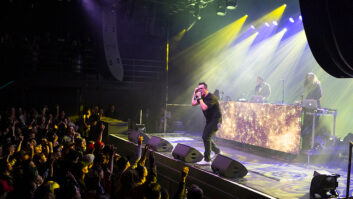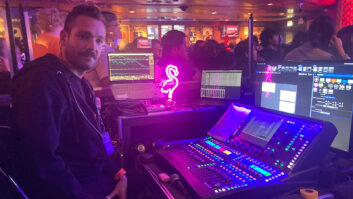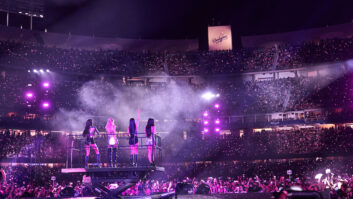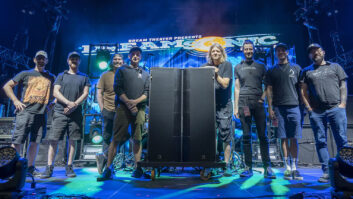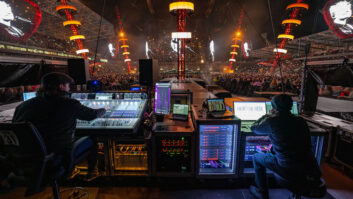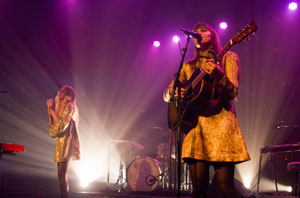
First Aid Kit performing at Union Transfer in Philadelphia in June 2014.
Photo: Todd Berkowitz
Johanna and Klara Söderberg, sisters from Stockholm, Sweden, front the band First Aid Kit, which includes drummer Niclas Lindsrom and Melvin Duffy on pedal steel and electric guitar. Johanna plays keyboard and keyboard bass, while Klara plays acoustic guitar. The quartet, founded in 2007, puts its own spin on folk and country music and is busy touring behind their June 2014 release, Stay Gold. They played mid-sized venues in the U.S. in spring 2014, before returning to Europe for a full slate of shows in the summer and fall, returning to the States again in October.
Johanna and Klara’s father, Benkt Söderberg, oversees the production. “I have actually worked with them from the very start,” he says. “I’ve helped them with recording songs in our home since they were teenagers. I also play the bass guitar on all of their albums, and I do their live sound. They do all song and lyrics writing, and I step in to help at a later stage.”
The band travels with full backline, DIs, mics and a single console, an Avid S3L with two Stage 16 remote I/O boxes. They use in-house P.A., cables, stands and monitors, including console and engineer. “So far the band uses wedges, except for the drummer, who’s on hardwired in-ears,” Benky Söderberg says. “At the moment we rely on the in-house or festival engineers to help us with mixing monitors. I’ve also mixed from FOH with a complete set of channels dedicated to monitors. It works well in a good room with high-end wedges and amps; otherwise it can be a real pain to chase feedback in monitors from front-of-house, especially in larger venues.”
Söderberg says that he chose the S3L “because it was the desk that best fit my needs. The Number One reason was the size and weight. I can carry the controller, engine and stage boxes on flights. Number two was its compatibility; my S3L show file, on a USB stick, has so far worked perfectly. The third reason was that it is very easy to record with Pro Tools. A Cat-5e cable and a Mac is all you need. No additional cards [are needed]; I can just import the show from the console to Pro Tools and push Record. I recorded production rehearsals with ease and, to my ears, [got] a very satisfying result. I also plan to make the band’s future demos with the S3L system as a hub. The fourth reason is the ability to run plug-ins.”
When it comes to the live mix, Söderberg says, “The vocals are the absolute core of First Aid Kit. I see as my main task to create a warm and full vocal sound. I ride the two vocals throughout each song, and overall I do small level changes on almost all instruments during a show. [Johanna and Klara] sing into Sennheiser e 965 condensers. I’ve recorded them with different mics, and the e 965 sounds the most smooth in the high-mids, with the least [amount of] ‘buzz.’
“I haven’t formulated any philosophy for front-of-house,” Söderberg continues, “but I want to stay close to the sound of the albums. I’ve been part of the production of the music from the very start and I play on the record so I would say that I know the songs quite well. I’ve also become more careful with using equalizers and effects. My experience is that I end up with a dull and hollow sound if I try to fight troublesome acoustics or an under-dimensioned P.A. system with equalizing. Phase error is another [way of putting it]. I also tend to use [fewer] reverbs. On the latest albums the main reverb is a vintage EMT; in accordance to that, I only use one, or maybe two reverbs in the live mix. And in reverberating rooms I cut all reverbs.
“I’m not sure how other engineers work but during a show, but if I’m not addressing a certain problem, I’m constantly listening through the mix and mentally ticking off each instrument: ‘Is the level good for this song, is the sound good?’ I like to mix loud. I want the show to be a physical experience as well as a spiritual one. On the other hand, I never strive to ‘get it as loud as possible.’ I can’t see the meaning of that, as too loud isn’t a pleasure but a pain. I really dislike when it’s so loud that I can’t tell if it’s my ears or the P.A. that are distorting.”
Will your next visit to the U.S. see production on a larger scale? “As we will play larger venues, we have to grow production-wise. I think it is important to have consistency, especially when it comes to monitors. We will have our own monitor engineer and a backline tech. We will also shift to IEM for all band members during this summer. I guess I won’t miss the leakage from the wedges. I’ll probably use the same console as I have now, as it is quite expandable, and maybe we will add another Avid S3L for monitors.
“It should be said that I never planned my daughters’ musical careers,” Söderberg adds. “Everything has so far been happy surprises.”
